Coronavirus crisis reveals poor state of Spanish apartments
The lockdown has highlighted the need to improve housing conditions in the country, as millions of homes lack balconies, natural light and proper ventilation


More than 1,000 hours of the coronavirus confinement measures have been enough to confirm the urgent need to improve housing conditions in Spain, especially regarding properties over 10 years old.
Many homes in Spain lacks proper ventilation and natural light, compromising comfort and health. Balconies are scarce in both old and new buildings and many interior apartments have no view of the street. Added to this, a number of apartments are so small there is little room for exercise or teleworking. But this is how millions of Spaniards live, whether they rent or own their homes.
If we are going to spend more time at home, we’ll need new spacesArchitect Julio Touza
“We architects must imagine and build homes that make natural light, ventilation and simple, comfortable movement a priority, regardless of the type of housing,” says architect Carlos Lamela.
Meanwhile, Sonia Hernández-Montaño, coordinator of health and architecture at the Catalan Architects Association, predicts that after the coronavirus crisis, “We are going to value flexibility of [space] distribution, natural light, views, the capacity for cross ventilation, acoustic factors and the existence of private exterior areas.”
The coronavirus pandemic has highlighted various shortcomings in housing and those who can, may consider moving once the lockdown, which has been in place since March 14, is over, especially if they have been renting substandard homes. This, in turn, will mean that many landlords will have to put in more of an effort if they want to continue making a profit. Homeowners, meanwhile, may want to rethink their homes as, according to Lamela, it is often a question of design rather than resources.
The lockdown has brought particular attention to balconies – or the lack of them in regions such as Madrid, which has been the hardest hit by the pandemic. Property owners who incorporated these spaces into an apartment in order to gain a few extra meters will now be regretting their actions as demand for housing with a balcony or garden has grown by 26% since the beginning of quarantine, according to property website Servihabitat.
“It is incomprehensible that balconies have allowed to be enclosed in Madrid,” says Lamela. “It is not something that happens in any other city or country and it is a real cancer in our urban planning.” Not only do balconies provide a small amount of outdoor space, they also protect building façades from the sun and rain. According to architect Julio Touza, “The balcony is going to gain prominence in size and quality. One of the lessons we have learned is to value this ‘in between space’ – this lung that lies between the street and the apartment.”
Building regulations in Madrid make balconies fair game for development. Consequently, they are often replaced or reduced to a minimum, a practice that does not happen in the regions of Valencia or Catalonia, where developers are encouraged to make them a feature.
The whole subject of balconies and terraces is of great interest to architects who hope that the municipal by-laws will be revised at the end of the crisis in order to promote “these spaces of respite” as they are referred to by José Antonio Tenorio, head scientist at the Eduardo Torroja-CSIC Institute of Construction Sciences.
Demand for housing with a balcony or garden has grown by 26% since the beginning of quarantine, according to property website Servihabitat
Harder to remedy are the shortcomings of interior apartments whose windows generally give onto the interior patio of the building, meaning that 7.9% of Spaniards are spending quarantine without so much as a view of the street. Of all regional capitals in Spain, Madrid has highest percentage of interior apartments (20.3%), followed by Bilbao and Cadiz, according to the property platform Idealista. “This should be dealt with via urban rehabilitation policies,” says Tenorio.
Tomorrow’s property will require flexible designs, facilitating the easy addition or removal of a room, as well as incorporating new spaces that can be used for teleworking and leisure activities, accommodating a culture that has emerged from the crisis and which is very likely here to stay.
“If we are going to spend more time at home, we’ll need new spaces,” says Touza, who proposes a return to the designs of the late 19th and early 20th century bourgeois homes in the Salamanca district of Madrid or the Eixample district of Barcelona, where there is generally a small library or office by the living room. “We must consider open, multipurpose and integrated spaces,” he says.
Multipurpose makes sense when work, entertainment and exercise will have a greater place in the home. Gonzalo Pardo, director of Gon Architects on the Houzz platform, believes that the greatest change will be the inclusion of spaces designed specifically for teleworking, and rooms that can be reconfigured according to the time of day.
Such a shift in demand has already been anticipated by new housing developments that are marketing apartments with a terrace and office and co-working areas in the building for residents. “The experience of confinement will increase the size and the use of communal areas and enhance neighborhood relations,” says Teresa Marzo, general business manager of the developers, Via Celere.
Health issues
Another issue the pandemic has flagged up is the importance of building with health conditions in mind. Only 2.3 million homes are built according to the Technical Building Code, which came into force in 2006 and promotes better quality construction. According to Enrique Rovira-Beleta, director of the accessibility department at the UIC Barcelona School of Architecture, the remaining properties lack natural light, proper ventilation and proper access. He believes that as the concept of a home changes, the regulations will be modified to ensure that the space in existing homes is better distributed, lit and ventilated. How? “By widening the windows, making some of the bathroom walls semi-transparent and broadening the corridors and doors to allow wheelchairs access,” he says.
Ventilation will be more important than ever, whether it is natural cross ventilation with opposing windows to allow a breeze through the apartment or ventilation using a device to suck out polluted air from within and replace it with filtered air from outside.
The next development on the cards is automated access to avoid tactile systems such as enhanced facial and voice recognition for doors, handles and elevators. “It’s using airport architecture, which is designed precisely according to hygiene criteria,” Touza says.
In the medium term, the use of anti-microbial materials could even be promoted. Pablo Muñoz, an expert in healthy building and managing director of the architecture firm Espacios Evalore, talks about photo-catalytic paint and anti-microbial handles, furniture and worktops. “Plants contribute to maintaining a relative indoor humidity of between 40% and 60% which, according to some studies, helps to reduce the transmission of the coronavirus,” he adds.
English version by Heather Galloway.
Tu suscripción se está usando en otro dispositivo
¿Quieres añadir otro usuario a tu suscripción?
Si continúas leyendo en este dispositivo, no se podrá leer en el otro.
FlechaTu suscripción se está usando en otro dispositivo y solo puedes acceder a EL PAÍS desde un dispositivo a la vez.
Si quieres compartir tu cuenta, cambia tu suscripción a la modalidad Premium, así podrás añadir otro usuario. Cada uno accederá con su propia cuenta de email, lo que os permitirá personalizar vuestra experiencia en EL PAÍS.
¿Tienes una suscripción de empresa? Accede aquí para contratar más cuentas.
En el caso de no saber quién está usando tu cuenta, te recomendamos cambiar tu contraseña aquí.
Si decides continuar compartiendo tu cuenta, este mensaje se mostrará en tu dispositivo y en el de la otra persona que está usando tu cuenta de forma indefinida, afectando a tu experiencia de lectura. Puedes consultar aquí los términos y condiciones de la suscripción digital.
More information
Últimas noticias
Most viewed
- Alain Aspect, Nobel laureate in physics: ‘Einstein was so smart that he would have had to recognize quantum entanglement’
- Maps of the US attack on Venezuela: Targets, airspace and deployed fleet
- David King, chemist: ‘There are scientists studying how to cool the planet; nobody should stop these experiments from happening’
- Key points of the military attack on Venezuela: Early morning bombings and a ‘captured’ president
- Maduro jailed in New York after his capture in Caracas










































